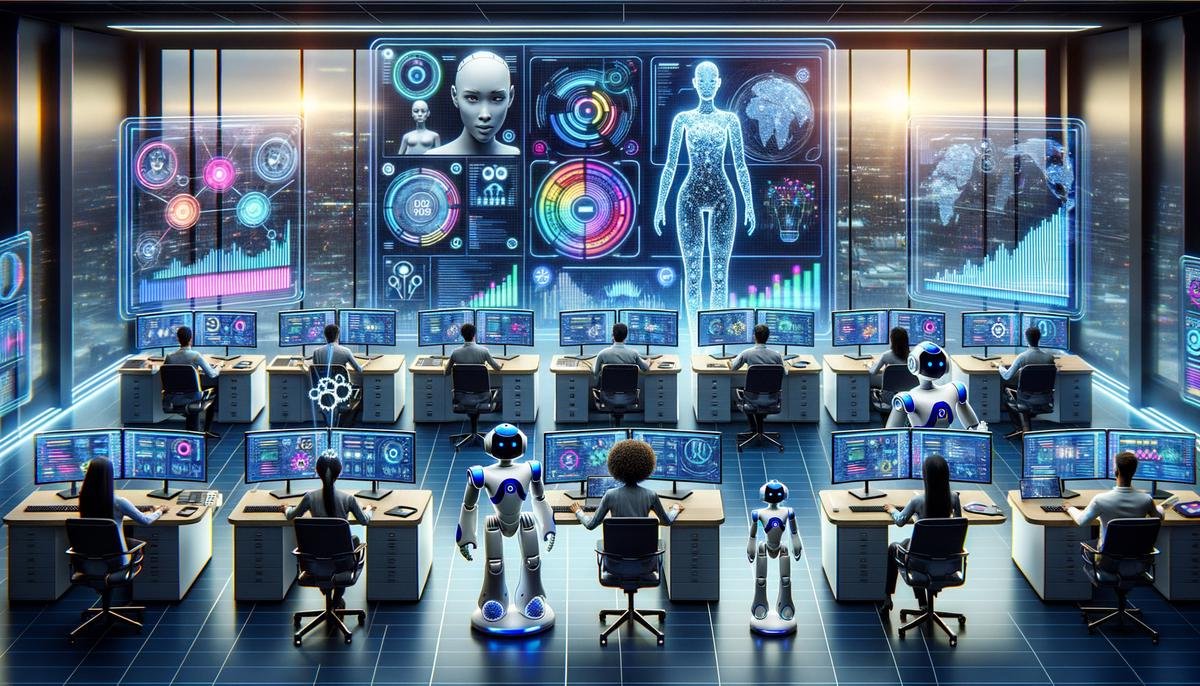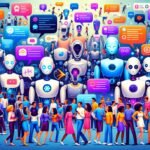The introduction of ChatGPT and its impact on customer support represents a significant shift in the way businesses interact with their clients. This development, rooted in advanced AI technology, offers a glimpse into a future where efficiency and customer satisfaction are paramount. As we explore the evolution and influence of ChatGPT, it’s clear that this tool is not just a new gadget but a transformative force reshaping the landscape of customer service.
The Genesis and Development of ChatGPT
ChatGPT and the AI Revolution in Customer Support
The world of customer support has witnessed a transformation with the emergence of AI technologies, particularly ChatGPT. Built on OpenAI’s GPT (Generative Pre-trained Transformer) architecture, ChatGPT has become a leading force in delivering automated, efficient customer service solutions. Its rise to prominence is not accidental but the result of strategic advancements in AI and machine learning, alongside growing business needs.
At its core, ChatGPT is crafted to simulate human-like conversation, enabling it to understand and respond to customer queries in real-time. This capability stems from its extensive training on diverse datasets, encompassing vast swaths of internet text. As a result, ChatGPT can process and generate responses that feel surprisingly natural and relevant to the user’s questions.
One of the key factors driving ChatGPT’s adoption in customer support is its scalability. Traditional human-led support systems have limitations in handling high volumes of simultaneous inquiries. ChatGPT, on the other hand, can manage thousands of interactions at once, ensuring that customer requests are addressed promptly, regardless of the time of day or surge in demand.
Moreover, ChatGPT’s ability to learn from interactions and improve over time presents a significant advantage. Through continuous use and feedback, it refines its understanding and response accuracy, thereby enhancing the quality of support provided. This learning mechanism, coupled with regular updates from OpenAI, ensures that ChatGPT remains at the cutting edge of conversational AI.
The integration of ChatGPT into customer support roles has also been facilitated by its flexibility. Businesses can tailor ChatGPT’s responses and conversational style to align with their brand voice and specific industry needs. This customization capability ensures that the AI-powered interactions maintain a level of personalization, which is critical in building customer trust and loyalty.
Privacy and security are paramount in customer support, and ChatGPT addresses these concerns through robust protocols. Given that customer interactions often involve sensitive information, ChatGPT is designed to comply with data protection regulations, ensuring that user data is handled securely.
The impact of ChatGPT on customer support is evident in its widespread adoption across various industries, from retail to banking. Companies report significant improvements in customer satisfaction scores and operational efficiency, underlining the tangible benefits of integrating AI into customer service frameworks.
Despite its advancements, ChatGPT is not without challenges. Ensuring that the AI understands the nuances of human emotions and sarcasm, for instance, remains an area for further development. However, the ongoing research and improvement efforts by OpenAI and its partners promise to overcome these hurdles, paving the way for even more sophisticated and empathetic AI-driven customer support solutions.
In sum, ChatGPT has emerged as a frontrunner in AI-driven customer support due to its conversational capabilities, scalability, learning ability, customization options, and attention to privacy and security. As businesses continue to seek ways to enhance customer experience and operational efficiency, the role of ChatGPT and similar AI technologies in customer support is set to grow, heralding a new era of AI-enabled service excellence.

Comparative Analysis of Automated Customer Support Systems
ChatGPT, when pitted against other automated customer support systems, holds a distinctive edge in several key areas. This analysis ventures into the comparative strengths and potential limitations of ChatGPT in the realm of customer service automation.
One significant contrast between ChatGPT and traditional customer support bots is in their processing of natural language. Where many systems rely on predefined responses to specific inputs, ChatGPT’s engine, powered by the GPT architecture, interprets and generates replies based on context. This capability not only makes interactions feel more natural and human-like but also enables the handling of a broader range of inquiries without explicit programming for each.
Moreover, ChatGPT stands out in terms of adaptability. While many automated systems are static, requiring manual updates and adjustments to evolve, ChatGPT learns from interactions. This feature ensures that the system continually refines its understanding and responses, potentially reducing the need for frequent manual intervention.
Integration flexibility also sets ChatGPT apart. Its architecture can be tailored and integrated into various platforms, from social media messaging to traditional customer service interfaces. This versatility means businesses can deploy ChatGPT across multiple customer touchpoints, ensuring a consistent experience regardless of how or where a customer chooses to engage.
On the downside, ChatGPT, like all AI-driven tools, faces challenges related to understanding complex human emotions and subtleties. While it significantly surpasses basic scripted bots in conversational nuance, there are instances where it may misinterpret sentiment or context, leading to unsatisfactory interactions.
Another essential consideration is the resource investment in training and maintaining ChatGPT. For optimal performance, particularly in specialized fields, the system requires extensive initial training and ongoing data updates. This requirement can present hurdles for smaller organizations or those with rapidly changing service portfolios.
Furthermore, ChatGPT operates within the limitations of its training data and algorithms, meaning there are instances where it might provide outdated or inaccurate information if the underlying data isn’t regularly reviewed and updated. This necessitates a robust oversight mechanism to ensure the accuracy and relevance of responses.
Regarding user experience, while ChatGPT generally offers a more engaging and fluid conversation than its counterparts, there is often a noticeable difference when compared to human agents, especially in complex scenario resolution or when empathy and understanding are paramount.
In summary, ChatGPT provides a sophisticated alternative to traditional automated customer support tools, offering significant advantages in language processing, adaptability, and integration. However, its effectiveness is contingent on careful management and oversight, particularly concerning knowledge updates, emotional intelligence, and the balance between automated and human service components. As customer service environments grow increasingly complex, ChatGPT represents a pivotal step forward but one that must be strategically implemented to realize its full potential.

Integration of ChatGPT in Business Operations
Integrating ChatGPT into business operations extends far beyond enhancing customer support services. Its adoption signifies a revolutionary shift in how businesses interact with technology and leverage it for efficiency, innovation, and strategic advantage. The implications of this integration permeate various facets of business operations, from internal processes to external communication strategies.
One notable application is in the realm of content creation. ChatGPT’s ability to generate coherent, contextually appropriate text in seconds transforms content strategy and production. Businesses can automate routine writing tasks, such as generating reports, creating marketing copy, or drafting responses to common inquiries, freeing up human creativity for more strategic or nuanced content challenges. This shift not only accelerates content production but also maintains a consistent brand voice across all channels.
Furthermore, the integration of ChatGPT into business operations heralds a new era in data analysis and decision-making. ChatGPT can process and analyze large volumes of data faster than traditional methods, providing insights that were previously inaccessible due to time or resource constraints. For instance, it can monitor customer feedback across platforms in real-time, offering businesses immediate insights into customer sentiment and trends. This capability enables more informed decision-making, allowing companies to respond swiftly to market changes or customer concerns.
Training and development within companies also stand to benefit significantly from ChatGPT. Personalized learning experiences can be crafted for employees, scaling the delivery of training materials and automating the feedback process. ChatGPT can simulate various scenarios, from customer service dialogues to leadership challenges, providing employees with a safe space to develop their skills. This adaptive learning approach can significantly enhance employee competencies, leading to a more agile and responsive workforce.
However, the integration of ChatGPT into business operations is not without its challenges. Ensuring that the AI understands and aligns with the company’s ethical standards and regulatory requirements is paramount. As businesses become increasingly reliant on ChatGPT for various tasks, the potential for misuse or errors stemming from biases in the AI’s training data could lead to reputational damage or legal issues.
In conclusion, integrating ChatGPT into business operations unleashes a multitude of benefits, from enhanced content creation and data analysis to improved employee training and development. As businesses navigate this new terrain, the balance between leveraging AI’s capabilities and managing its challenges will define the next wave of innovation and competitiveness in the digital age.

The Future of Automated Customer Support Systems
In today’s fast-paced business environment, the influence of artificial intelligence (AI) on automated customer support systems cannot be underestimated. As these technologies evolve, they’re setting the stage for a revolution in how companies interact with their customers. While the previous sections have thoroughly covered the role, capabilities, and the broader implications of AI technologies like ChatGPT, it’s essential to delve into the upcoming trends that are shaping the future of automated customer support systems.
Increased Use of Voice Assistants and Conversational AI
One significant trend is the rise of voice assistants and conversational AI platforms. These systems are becoming more sophisticated, understanding and processing natural language at impressive levels of accuracy. As a result, businesses are increasingly incorporating these solutions to provide more intuitive and accessible customer support. This move aligns well with the consumer’s growing preference for voice commands, making customer service interactions more efficient and aligning with the general shift towards voice-based computing.
Proactive Customer Support Initiatives
Another trend gaining momentum is the shift from reactive to proactive customer support. AI-driven systems are now capable of predicting customer issues before they escalate, thanks to advanced machine learning algorithms. By analyzing customer data and interaction patterns, these systems can identify potential problems and address them proactively, improving customer satisfaction and loyalty.
Emphasis on Hyper-Personalization
Hyper-personalization is set to redefine customer support. AI systems are being trained to deliver personalized experiences at scale, using customer data to tailor interactions based on past behaviors, preferences, and needs. This level of personalization extends beyond addressing the customer by name to understanding their history with the brand and providing customized solutions based on that understanding.
Integration of Augmented and Virtual Reality
The integration of augmented reality (AR) and virtual reality (VR) into customer support scenarios is an exciting development. These technologies offer immersive ways for customers to troubleshoot problems, access information, or even experience products before purchase. For instance, a customer could use VR to visualize how a piece of furniture would look in their home or follow AR-guided instructions to solve a technical problem with a device. This integration not only enriches the customer experience but also opens new avenues for interactive customer service.
Ethical AI and Transparency
Finally, as AI systems become more ingrained in customer support, there’s a growing emphasis on ethical AI and transparency. Consumers and regulators alike are calling for clearer explanations of how AI makes decisions, especially in cases where these decisions directly affect customer outcomes. This push for transparency is leading to the development of more explainable AI systems, which can articulate their decision-making process in understandable terms, thereby building trust and ensuring fairness.
In conclusion, the future of automated customer support systems is being shaped by several dynamic trends, including the expansion of conversational AI, the move towards proactive support, hyper-personalization strategies, the integration of immersive technologies, and a strong focus on ethical AI practices. These trends underscore the ongoing evolution of customer service, where technology enhances human interaction rather than replacing it, ultimately striving for a balance that puts customer needs and experiences at the forefront.

As we consider the landscape of customer support and business operations transformed by AI and ChatGPT, it becomes evident that we stand on the brink of a new era. ChatGPT does more than answer customer queries; it represents a leap forward in how businesses offer personalized, efficient, and engaging customer service. The future, ripe with possibilities, promises an environment where AI enhances every facet of customer interaction, making each experience more rewarding and every solution more accessible.




